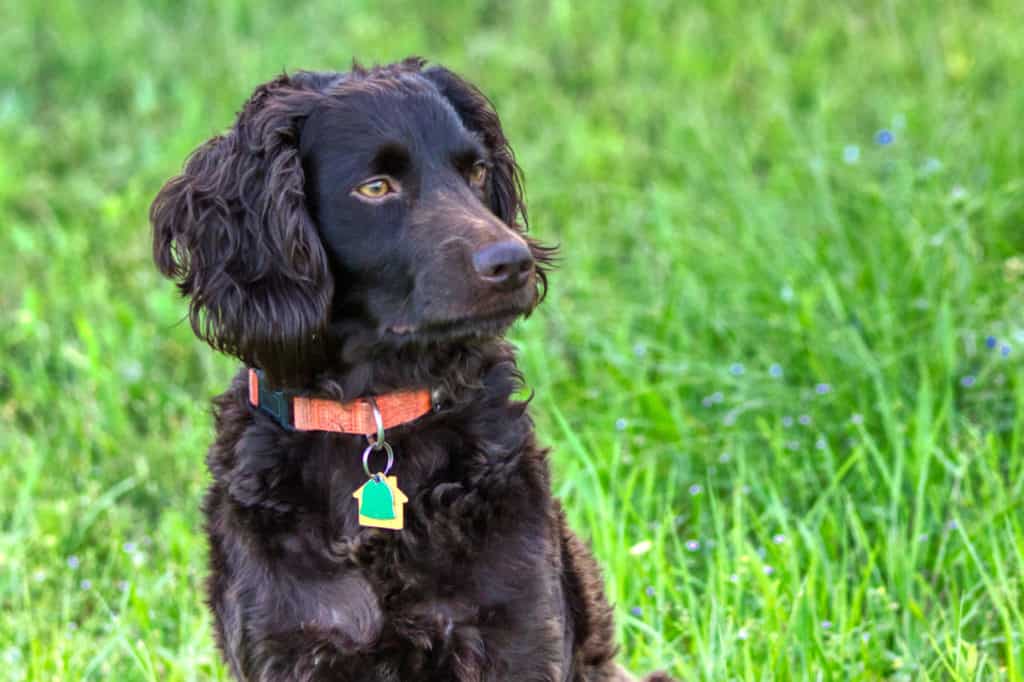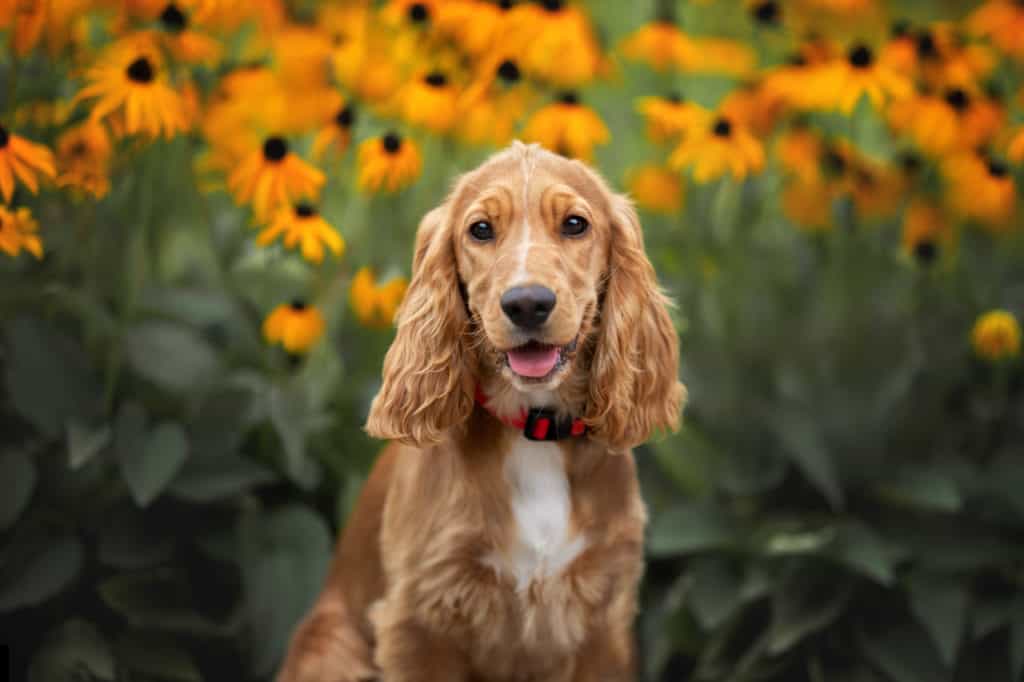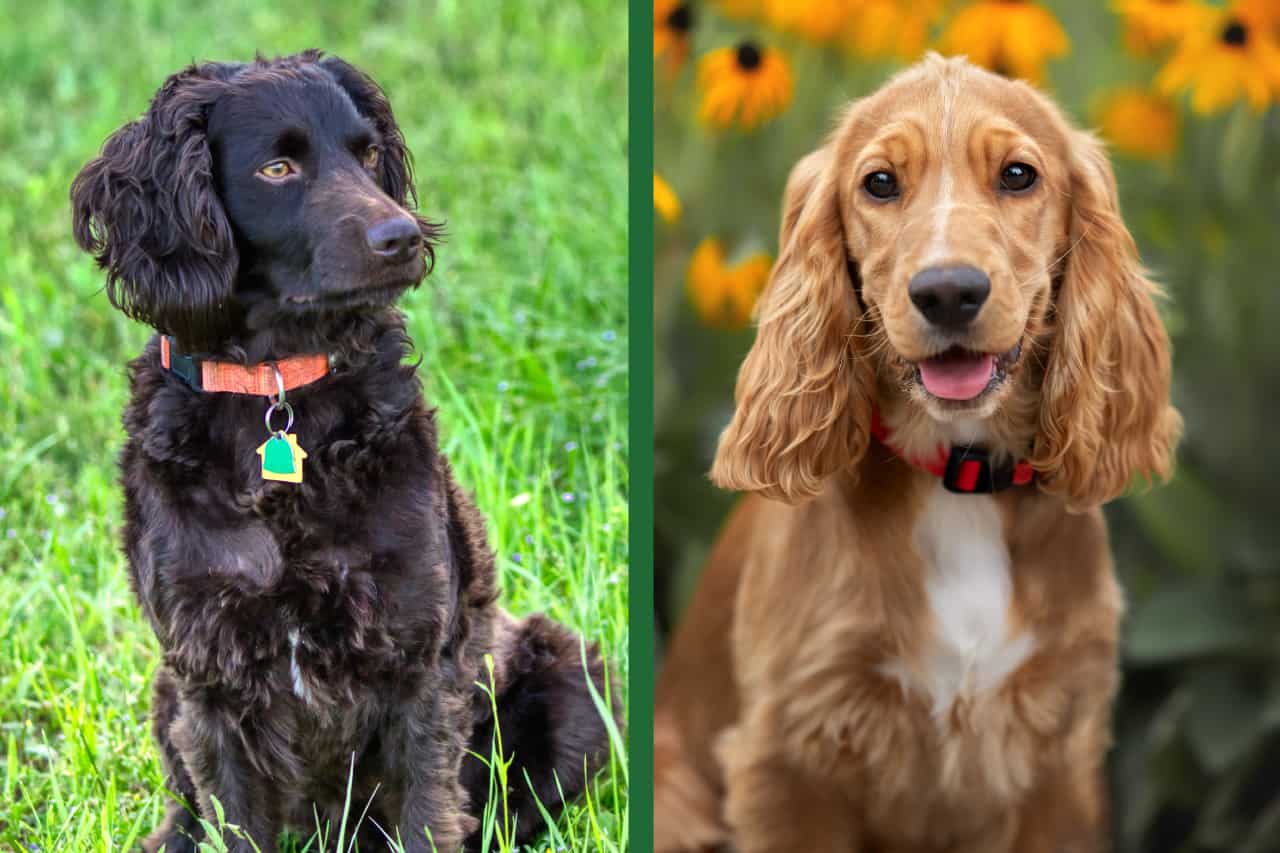Until the 19th-century, Spaniels were known as either land Spaniels or water Spaniels, with no distinct breeds. With the rise in popularity of purebred dogs, written breed standards, and dog showing, the individual Spaniel breeds began to be separated.
Boykin and Cocker Spaniels look different. Boykins are easier to groom. They are more independent, tolerant of being alone, and child friendly. They require more active owners and exercise. Cockers are more sensitive, needy, and stranger-friendly. They are better for new owners and apartments.
If all Spaniel breeds had the same origins, how different can they be? The answer is: very different! While there are similarities–after all, they were bred for the same purpose–the differences between a Boykin Spaniel and a Cocker Spaniel can be easily seen and observed. Does this mean that one Spaniel breed is better than another? Not at all. It depends on what you are looking for, what will suit your lifestyle, and if you can provide the right home for the Spaniel.
If you are trying to decide between a Boykin Spaniel and a Cocker Spaniel, or even if you are simply just interested in what the difference may be, the following article has been composed with the intention of providing you with a comprehensive comparison of these two fantastic breeds.
Questions To Ask Before Deciding On A Boykin Spaniel Or Cocker Spaniel
You have made the decision to open your heart and home to a dog; you have scoured the internet and whittled your choices down to two breeds: Boykin Spaniels and Cocker Spaniels. Here are a few helpful questions for you to ask yourself before making a choice between these two dog breeds. When you have established the answers to these questions, you can see which Spaniel will be the better fit.
- How much time can I devote to dog grooming?
- Will I get frustrated with a needy dog?
- Will I be overwhelmed by an intense dog?
- Do I live with children, or are children frequently in my home?
- Will my dog need to be good with strangers?
- How much time do I have to exercise my dog?
- How often and how long am I away from home?
- Where do I live? (City/countryside; yard/apartment; hot climate/cold climate)
- How much money can I pay for my dog?
Boykin Spaniel vs. Cocker Spaniel: Classification, Lifespan, And Appearance
| BOYKIN SPANIEL | COCKER SPANIEL | |
| AKC Classification | Sporting group | Sporting Group |
| UKC Classification | Gun Dog Group | Gun Dog Group |
| Alternative Classification | Bird Dog – Flusher | Bird Dog – Flusher |
| Other Names | Boykin; Swamp Poodle; Little Brown Dog | American Cocker Spaniel (in the UK and other parts of the world) |
| Lifespan | 10 – 15 Years | 10 – 14 Years |
| Male Height | 15.5 – 18 in | 14.5 – 15.5 in |
| Female Height | 14 – 16.5 in | 13.5 – 14.5 in |
| Male Weight | 30 – 40 lbs | 25 – 30 lbs |
| Female Weight | 25 – 35 lbs | 20 – 25 lbs |
| Coat Length | Medium | Medium to long |
| Coat Characteristics | Flat, wavy, or curly | Silky; flat to slightly wavy |
| Undercoat Characteristics | Thick | Moderate |
| Feathering | Light feathering on ears, chest, legs, and belly | Chest, ears, abdomen, and legs are well-feathered |
| Coat Colors | Solid liver color, including light to dark chocolate; white patch on chest (sometimes) | Solid black; black with tan points; any solid color other than black; brown with tan points; small white patch on chest (sometimes) |
| Hypoallergenic Coat | No | No |
| Head Shape | Not domed; medium length muzzle | Domed; muzzle is short but proportional to skull length and not flattened |
| Ears | Hang down; long | Hang down; very long; well-feathered |
| Eyes | Yellow, amber, or brown (various shades); not protuberant | Dark brown; round, but not protuberant |
Summary Of The Main Classification, Lifespan, And Appearance Differences
- Boykin Spaniels are larger and heavier than Cocker Spaniels.
- Boykin Spaniels have shorter coats with less feathering than Cocker Spaniels.
- Cocker Spaniels come in more colors than Boykin Spaniels.
- Cocker Spaniels have domed heads, proportionally broader muzzles (compared to skull size), with heavier jowls than Boykin Spaniels.
- Cocker Spaniels have longer and hairier ears than Boykin Spaniels.

Boykin Spaniel vs. Cocker Spaniel: Grooming Requirements
| BOYKIN SPANIEL | COCKER SPANIEL | |
| Maintenance Intensity | Minimal | High |
| Brushing | 2 – 3 times per week | Daily; if tangled or matted, be gentle |
| Bathing | Once a month; when dirty from outdoor work or activity | Once a week if the coat is kept long; every two weeks if the coat is kept shorter; wash thoroughly and ensure no shampoo remains on the substantial coat |
| Trimming and Clipping | Not necessary; however, if feathers become matted, may have to trim them | Trim once a week if the coat is kept long; can clip to maintain at a shorter length |
| Shedding | Seasonal | Occasional |
| Ears | Checked daily; cleaned weekly; hair carefully brushed weekly | Checked and cleaned daily; hair carefully brushed daily |
| Nails | Trim monthly; no special notes | Trim every few weeks; no special notes |
| Teeth | Brush regularly; no special notes | Brush regularly; no special notes |
Summary Of The Main Grooming Differences
- Boykin Spaniels require lower overall grooming maintenance in comparison to the Cocker Spaniel.
Boykin Spaniel vs. Cocker Spaniel: Temperament
The following information is a generalized temperament based on the breed standard and the most commonly seen behaviors and characteristics. Other factors, such as personality, age, quality of breeding, socialization, training, history, and living environment can all influence a Spaniel’s temperament.
Temperament is also not a definitive point but rather a scale. For example, many individual dogs can be described as friendly, but there are different and subjective degrees of friendliness, from sweet to exuberant.
| BOYKIN SPANIEL | COCKER SPANIEL | |
| General Temperament (AKC) | Friendly, eager, and lovable | Gentle, smart, and happy |
| Affectionate (to family) | Very affectionate to the whole family | Very affectionate to the whole family |
| Independence | Moderate | Low |
| Intensity | High | Low to moderate |
| Sensitivity | Moderate to high | High |
| Stubborn | Possible | Possible |
| Aggression Level | Low | Low (can be snappy if not well-socialized and trained); badly bred Cockers can have high aggression levels |
| Timid | No | Possible |
| Energy Level | Moderate to high | Moderate to high |
| Attention Requirements | Moderate to high | High |
| One-Person Dog | Possible, not to the exclusion of other family members | Possible, not to the exclusion of other family members |
| General Friendliness | High | High |
| Child Friendliness | Moderate to high; may not be happy with rough treatment from very young children | Low to moderate, especially with small children; better if raised with the children |
| Stranger Friendliness | Moderate | Moderate to high |
| Dog Friendliness | High | High |
| Cat Friendliness | Moderate if raised with them | Low to moderate |
| Other Pet Friendliness | As bird dogs, pet birds may be a problem | As bird dogs, pet birds may be a problem |
| Protectiveness | Low | Low; can be vocally protective of territory |
| Prey Drive | High | High |
| Barking Potential | High | High |
Summary Of The Main Temperament Differences
- Boykin Spaniels are more independent and intense than Cocker Spaniels.
- Cocker Spaniels are more sensitive and needy than Boykin Spaniels.
- Boykin Spaniels are typically better with children than Cocker Spaniels.
- Cocker Spaniels are friendlier towards strangers than Boykin Spaniels.
Boykin Spaniel vs. Cocker Spaniel: Exercise And Training Requirements
| BOYKIN SPANIEL | COCKER SPANIEL | |
| Socialization | Required | Required |
| Intelligence Level | High | High |
| Endurance | High | High; their small size means they work harder to keep up, so bear this in mind |
| Eager to Please | Very | Very |
| Exercise Needs | Moderate to high | Moderate |
| Exercise Frequency | 1 – 2 times a day | 1 – 2 times a day |
| Exercise Duration | 1 – 2 hours | 30 minutes |
| Exercise Intensity | Moderate to high* | Moderate |
| Owner Requirements | Active | Moderately active |
| Exercise Companion | Excellent; can accompany owner when cycling, hiking, kayaking, and running | Good; can accompany owner on short to moderate walks |
| Toilet-Training | No breed issues | No breed issues |
| Training Methods | Positive preferred | Positive only |
| Mandatory Training | Obedience | Obedience |
| Crate Training | Possible | Possible |
| Canine Sport Training Options | Agility; field events; hunting; rally, tracking | Agility; field events; hunting |
| Off-Leash | Only with good training | Only with good training |
| Affinity for Water | High | Moderate |
| Self-Exercise | Possible, but prefer companion exercise with owners or other dogs | Unlikely because they are very attached to their owners |
* Caution: Boykin Spaniels are at risk of exercise-induced collapse and should be tested for the genetic markers and closely monitored during all exercise sessions.
Summary Of The Main Exercise And Training Requirement Differences
- Boykin Spaniels require more exercise than Cocker Spaniels.
- Boykin Spaniels require a more active owner and lifestyle than Cocker Spaniels.
- As waterfowl bird dogs, Boykin Spaniels have a higher affinity for water than Cocker Spaniels.

Boykin Spaniel vs. Cocker Spaniel: Adaptability And Living Environment
| BOYKIN SPANIEL | COCKER SPANIEL | |
| Good for First-Time Owners | No | Possibly |
| Good for Single-Person Homes | Moderately; owner must meet dog’s exercise and attention requirements | No; the high attention requirements of these dogs are better shared by many people |
| Good for Multi-Person Homes | Yes | Yes |
| Alone Time | Tolerate some | Intolerant; prone to separation anxiety |
| Indoor Living | Should be allowed indoors with family; not good for apartment living | Should be allowed indoors with family; can adapt to apartment living |
| Outdoor Requirements | Should have access to a secure yard; should be taken outside each day | Should be taken outside each day |
| Toleration of Cold Weather | Moderate | Good |
| Toleration of Hot Weather | Good | Moderate |
| Wanderlust | Possible to likely | Unlikely to possible |
Summary Of The Main Adaptability And Living Environment Differences
- Cocker Spaniels are a better choice for novice owners than Boykin Spaniels.
- Boykin Spaniels are more tolerant of being left alone for a few hours than Cocker Spaniels.
- Cocker Spaniels can adapt to apartment living, whereas Boykin Spaniels are not suited to apartments without free access to a yard.
Boykin Spaniel vs. Cocker Spaniel: Health Concerns
One of the primary ways to reduce the risk of your Spaniel developing any of these disorders is to get them from a reputable breeder. Reputable breeders will test breeding pairs for these conditions before breeding with them. They will also often test the puppies before selling them. Not all conditions can be predicted, but a reputable breeder will not breed with dogs that have a history of adverse health conditions.
| BOYKIN SPANIEL | COCKER SPANIEL | |
| Exercise-Induced Collapse | Prone | Should be tested |
| Joint, Ligament, Muscle Conditions | Hip dysplasia | Hip dysplasia; Patella luxation |
| Cardiovascular Conditions | Pulmonic stenosis | No breed issues |
| Blood Conditions | Hemophilia A | Autoimmune hemolytic anemia |
| Eye Conditions | Juvenile cataracts; distichiasis | Progressive retinal atrophy; glaucoma |
| Ear Conditions | Watch for infections caused by excessive swimming | Prone to ear infections |
| Skin Conditions | No breed issues | Primary seborrhea |
| Allergies | No breed issues | Common |
| Rage Syndrome | No breed issues | Rare but most frequently documented in Cocker Spaniels |
| Potential for Obesity | Moderate to high | High |
Brief Descriptions Of These Health Conditions
- Exercise-induced collapse: Dogs with this disorder will not tolerate strenuous or excessive exercise. If they exercise too much, they will lose partial to total neuromuscular control of their movements and may collapse. The dogs will recover from these episodes, but episodes should be avoided completely to ensure the best health for your dog.
- Hip dysplasia: This condition describes a deformity of the hip joint resulting in excessive wearing, gradual deterioration, and eventually complete loss of function.
- Patella luxation: Dogs with this condition have recurring, semi-permanent, or permanent kneecap dislocation. There are different grades of Patella luxation; some are momentary dislocations that correct themselves; others require surgical correction.
- Pulmonic stenosis: This is a congenital condition characterized by constriction of the pulmonary heart valve, interfering with the flow of blood from the heart to the lungs.
- Hemophilia A: This is a congenital blood clotting disorder that increases the chance of trauma-induced or spontaneous internal bleeding.
- Autoimmune hemolytic anemia: This disease results in the spontaneous destruction of red blood cells, interfering with oxygen transport around the body.
- Juvenile cataracts: Cataracts describe a clouding of the lens in the eye and are usually associated with age. Juvenile cataracts can develop even in puppies.
- Distichiasis: In this condition, eyelashes grow in abnormal locations on the eyelid, typically on the underside of the eyelid, in which location they cause irritation to the eyeball.
- Progressive retinal atrophy: This is a degenerative disorder affecting the photoreceptors of the retina and leading to blindness.
- Glaucoma: Dogs with glaucoma have a build-up of pressure in the eyeball. It is a painful ocular disease and can lead to blindness.
- Primary seborrhea: In this condition, the skin produces an excess of sebum, which irritates the skin, causing scaling, flaking, itchiness, and redness.
- Rage syndrome: This is characterized by explosive, inexplicable aggression towards someone (person or animal). It is episodic, and once the episode is over, the dog will act as if nothing happened. It is thought to be a form of epilepsy.
Boykin Spaniel vs. Cocker Spaniel: Cost
Boykin Spaniels are rarer than Cockers Spaniels and tend to cost more. Looking at the AKC-associated puppy breeders, Boykin Spaniel puppies are sold for an average of $2500, while Cocker Spaniel puppies are sold for an average of $1800.
Rescuing a Boykin Spaniels or a Cocker Spaniel will cost less and may even level the field in terms of the purchase price. You can approach Spaniel rescue organizations or animal shelters and ask them if they have any Boykins or Spaniels that need a home.
Conclusion
Boykin Spaniels and Cocker Spaniels are both flushing bird dogs used for hunting. They are very different in their appearance. Although they share many similarities of temperament and requirements, there are enough differences that one of these dogs may be the perfect match for you, while the other one may be quite unsuitable.
Boykin Spaniels need experienced, active owners, a yard, lots of exercise, and minimal grooming. Cocker Spaniels are more suited to novice owners and apartment living; they require less exercise than a Boykin Spaniel but significantly more grooming.
Boykin Spaniels are more independent and intense dogs, but they tolerate being left alone for a few hours at a time. Cocker Spaniels are more sensitive and needy, and they are very unhappy when left alone.
Both Spaniels are friendly with their families and bond closely with them. A Boykin Spaniel is better with children than a Cocker Spaniel, but a Cocker Spaniel is friendlier towards strangers.
To choose between these two excellent bird dog breeds, you really have to consider which breed will best suit your personality and home environment.
References
https://www.akc.org/dog-breeds/boykin-spaniel/
https://www.orvis.com/boykin-spaniel
https://dogtime.com/dog-breeds/boykin-spaniel#/slide/1
https://www.ukcdogs.com/boykin-spaniel
https://www.hillspet.com/dog-care/dog-breeds/boykin-spaniel
https://dogtime.com/dog-breeds/cocker-spaniel#/slide/1
https://www.orvis.com/cocker-spaniel
https://www.akc.org/dog-breeds/cocker-spaniel/
https://www.ukcdogs.com/cocker-spaniel
https://www.dog-learn.com/breed-vs-breed/boykin-spaniel-vs-english-cocker-spaniel/
https://vgl.ucdavis.edu/test/exercise-induced-collapse
https://veterinarypartner.vin.com/default.aspx?pid=19239&id=4952566
https://www.ncbi.nlm.nih.gov/pmc/articles/PMC6055891/
https://www.petmd.com/blogs/purelypuppy/lradosta/2012/aug/juvenile_cataracts_puppy-26754
https://vcahospitals.com/know-your-pet/distichia-or-distichiasis-in-dogs


